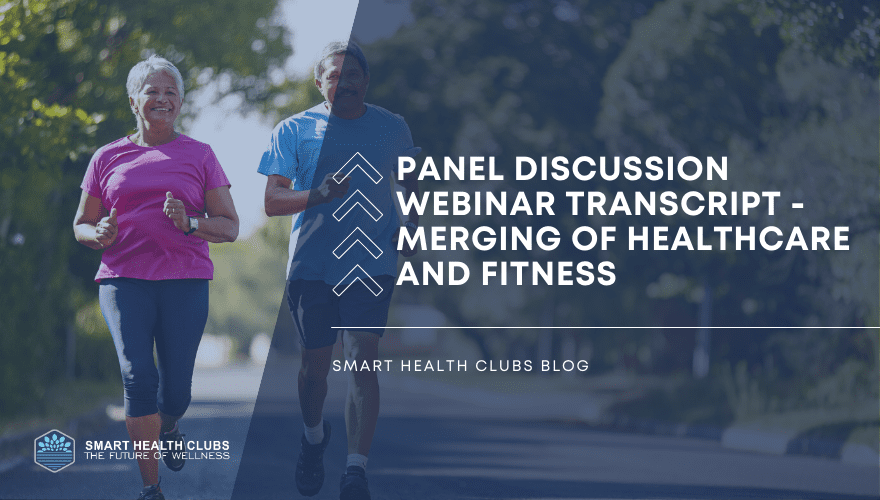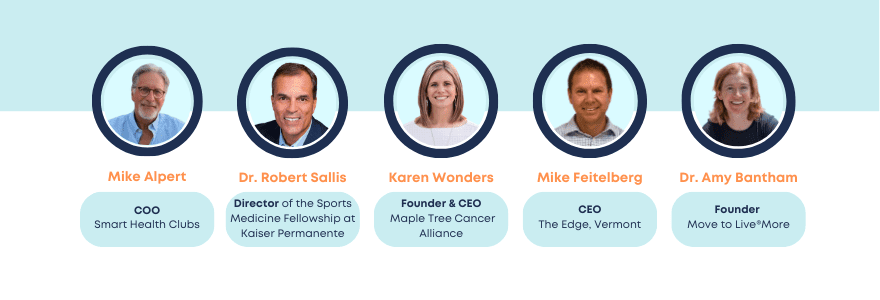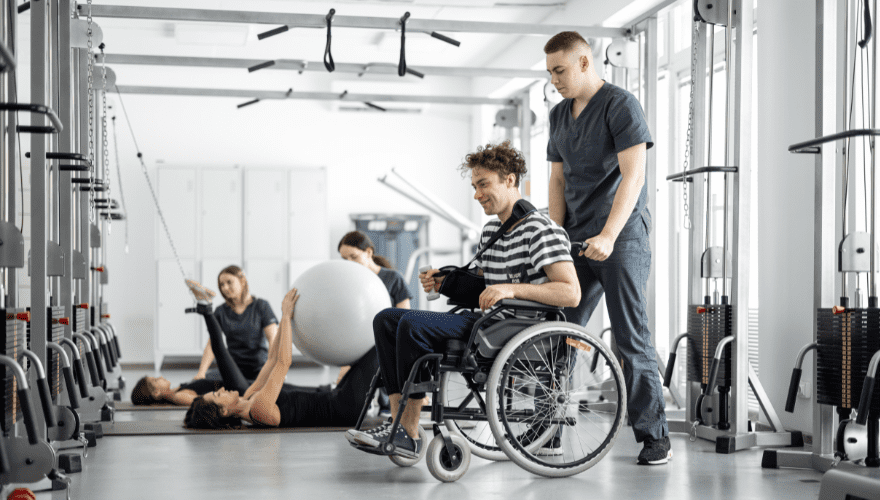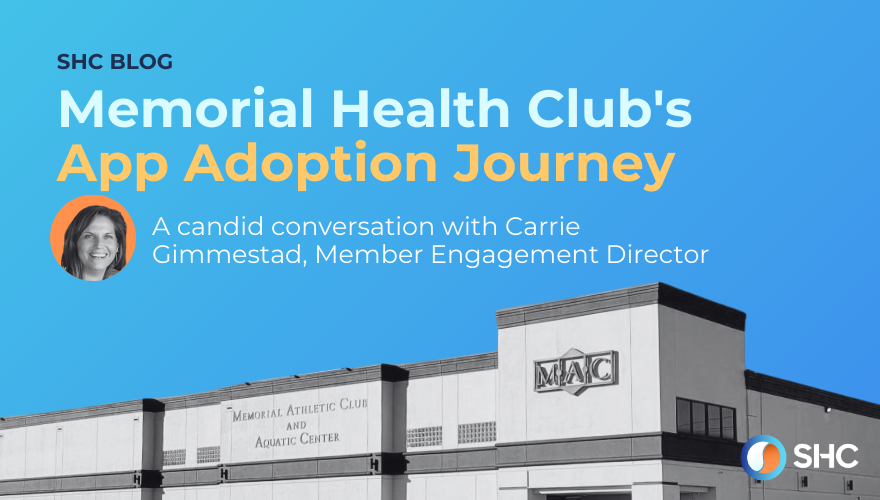
Merging of Healthcare and Fitness – The New Pathway to Growth.
Introduction
Millions of Americans are unhealthy today.
As Healthcare costs continue to rise, patient outcomes are nowhere near satisfactory.
With rising healthcare costs and worsening patient outcomes – patient treatment goes far beyond just medicine.
For people with chronic illnesses, disabilities, and injuries, exercise and nutrition are absolutely essential. We believe that exercise IS medicine.
We need to integrate healthcare and fitness, this is the future of fitness
But the question is – Can the Healthcare and Fitness industries work together?
To answer this question, we conducted a panel discussion “Merging of Healthcare and Fitness- The New Pathway to Growth”.
Expert Panelists:

Agenda:
- The value merging Healthcare and Fitness can bring to the patient, the Health Club, and the Hospital
- Using “Exercise is Medicine” to treat people with chronic diseases
- Patient Assessment and prescriptions for exercise
- Role of Health Clubs in patient recovery
- Benefits of Maple Tree programs for cancer patients
If you wish to watch the webinar, here is the replay:

What is the merging of healthcare and fitness? Is it feasible?
Mike Alpert – This topic is very important for Healthcare and Fitness Industry and let’s
begin our discussion now with our first question that I would like to address to Dr.Robert Sallis.
Question – Bob, you’ve been the leading advocate to merge healthcare and fitness since you started the Global Initiative of Exercise as Medicine while serving as the president of the American College of Sports Medicine back in 2007.
Please tell us what merging health care and fitness means to you.
Where did it come from and is it feasible?
Dr.Robert Sallis – I’ve been a family medicine physician going on over 30 years now, and I’d tell you, it wasn’t long into my career that I began to realize most of the stuff we do does not have that much of an impact from all the pills and procedures, they are bankrupting the world with health care costs.
I was I feel like it’s always over-promising and under-delivering with health care.
And at the same time, I began to observe that patients who came into my office, and who were doing regular physical activity, particularly elderly patients, had just dramatically better outcomes.
Through my involvement with the American College of Sports Medicine, I got involved and met a lot of the researchers who had documented the health benefits of physical activity.
It occurred to me, why would we not be leveraging this in health care?
At Kaiser Permanente, we begin using exercise as a vital sign.
I have found that my patients who I can get to be more active have a dramatic effect on everything from mental health, cardiovascular health, flexibility, and the ability to do the activities of daily living.
I’m convinced that we could do more for the health of America by promoting physical activity than setting an emphasis on pills and procedures. And we could do it at a much cheaper cost.
Yes, I think it’s feasible to do this. And I think we have a group here that I love to hear ideas on how we could make that better happen.
What are the barriers to Integrating Healthcare and Fitness?
The next question is for Amy Bantham
Question – Amy, tell us what you think have been the barriers to the health and fitness industry supporting exercise is medicine.
And is that changing today?
Amy Bantham – I think there are three main barriers to the health and fitness industry integrating with health care yes, I do think that’s changing.
So, what are these three barriers that I’ve seen?
- The first is what has historically and traditionally been seen as a success in the health and fitness industry. It was really founded to help fit people get even fitter, and it wasn’t founded thinking about how to best serve the needs of people with chronic conditions.
I think that’s changing now in a very disrupted health and fitness industry with and it’s very much driven by consumer demand, consumers looking for inclusive environments, programs, and services, and they want health and fitness facilities that can provide those.
- The second barrier is that for health and fitness clubs, thinking about being in this space, it’s very daunting to get started. I have put together a roadmap for health and fitness centers seeking to get started based on my research.
It spells out you need to start with evidence-based programs and services. You need to promote those programs and services to members and potential members, and you need to measure the impact of your programs on health outcomes and communicate those health outcomes to healthcare providers.
- The third barrier comes down to building trust and relationships, and it takes a lot of time to build trust and relationships with health care there.
I found in research that there is a trust gap. And what I mean by this is health care providers are much more comfortable referring to medical fitness than they are to commercial fitness. I found that over half of physicians would refer to medical fitness, but only about a quarter would refer to commercial fitness.
So overcoming that trust gap is required, if you’re a commercial health and fitness operator, it takes time, it takes relationships, measurement, and communication of health outcomes.
But it can be done.
As a club operator, Mike Feitelberg agrees with the stated barriers.
From his experience it was one of the biggest challenges when he first got started, he was spending time with physicians and trying to incorporate them into fitness. And it did take a long time. It did take time to bring trust and evidence-based provable outcomes.
It was the big difference we were able to bridge that gap and was able to provide medical practitioners with the necessary data to show them that our standards and practices, and we were providing reliable outcomes that they could trust.
We spent a lot of time cultivating those relationships, spanning a lot of time, inviting them in, not just the doctors, but their staff so they could experience what we were doing and how we were doing it.
Dr. Robet Sallis adds that the health club can be an intimidating place for somebody with type two diabetes. You know, most of them don’t look great in spandex, let’s face it. And coming to a health club can be kind of intimidating for them.
Introduction to Maple Tree Cancer Alliance and its role in promoting the Benefits of Exercise in improving patient outcomes
Moving further, the next question is for Karen Wonders.
Can you tell us a little bit about Maple Tree Cancer Alliance and how you started it?
Karen Wonders – Maple Tree Cancer Alliance is a nonprofit organization that I started back in 2011. We provide individualized, supervised exercise to patients as they’re going through cancer treatment. And really, it takes place at any point during their cancer treatment trajectory so it can be anywhere from the time of diagnosis through survivorship. Sometimes we’ll have patients who are 20 years out of cancer treatment and they’ll want to come and exercise that maple tree.
I started Maple Tree out of the work I had done in my doctoral program. In 2003, I started my doctoral program at the University of Northern Colorado and had the opportunity to study under Dr. Carol Schneider, who was one of the founding researchers in the field of exercise oncology. I was very young and didn’t know very much about cancer.
But while conducting the research I saw the benefits that individuals had when they were going through treatments. I didn’t realize at the time that this was not already standard of care.
So before my doctoral work, I had done work in cardiac rehab, which is the standard of care for cardiac patients. I wrongly assumed that it was the same way for cancer. After graduation, I moved to Ohio and started working as a professor, a year later, my grandfather was diagnosed with colon cancer and was told not to exercise by his oncologist. Even when I pushed, his oncologist did not know the research and benefits of exercise.
That’s what led me to start Maple Tree was to try to change that narrative and educate not only oncologists but patients and caregivers about the benefits that exercise can bring to someone who’s battling cancer.
I have done studies on over 11,000 people with cancer using exercise and have been able to show fantastic results.

Treatment of Chronically ill patients with Exercise
Our fourth panelist Mike Feitelberg answers the questions
Question – Can you tell us how you are using exercise to treat people with chronic diseases?
Mike Feitelberg – It’s a collection of what we were just discussing.
We all know the figures in terms of the population 20% of our population is familiar with what we do (using exercise to treat chronic diseases). 80% is not and how are our clubs going to reach that 80%?
A lot of them need our help and these are oftentimes people with chronic disease or borderline.
We try to do something in which we are strengthening people both physically and mentally. A lot of times in our Lifestyle programs we are able to work with people that wouldn’t typically come to the club with the idea of creating a supportive and inspiring environment and work with folks who make them feel the most comfortable, and then try to expose them to as many different facets of the club like exercise, yoga class, pickleball, group X, doing something in which they find comfort.
We find that doing this brings patients into the club setting, and brings them into the environment in such a way that they’re they feel good about the process.
And around 80% of the folks that have never been in the club or participate in one of our programs because of a chronic illness, tend to stay beyond the program.
On average 80% of the total will stay beyond the program and come in as a traditional member.
That’s what we love because we know that that person has created a healthy habit and positive mind and they’re going to see the lasting results.
Mike Alpert adds that the socialization piece is so important and the part of it getting patients out of that secure environment, getting them into a more electric and social environment certainly helps quite a bit.
Dr. Robert Sallis mentioned that as a family medicine physician, my patients who belong to a health club, for the most part, I’m not worried about them. I’m more worried about the ones that never belonged. If there was an easy entry, it could be tremendously beneficial.
Here are a few comments and responses from the attendees.
Cosmo Wallen –
I have been consulting in this space for 20 years, and I believe the greatest barrier is that the medical world and commercial world speak different languages. And while I agree with Dr. Amy that trust is necessary, it is often challenging to trust someone you cannot fully understand. We all need to work harder to bridge the communication gap before we can address the trust.
Amy Bantham’s response – I think that communication is absolutely critical.
And in the ten-step roadmap that I put forth for health and fitness operators, I would say the majorly we are missing education and awareness, communication collaboration. The end goal is trust, communication is the tool through which we fill the trust gap.
Mike Feitelberg mentioned, one of the things that we found helpful is to share as much data back to the physicians after someone participated in a program. We were finding that connection between the physician, health coaches, personal trainers, or registered dietitians, and linking everybody together has made a big difference.
Adding further, the industry needs to have standards and the language that the fitness industry needs to work up to have those relationships with the medical community be as seamless as possible and work within those systems for maximum results.
Monica Forquer asks –
I wonder if many healthcare providers are concerned about recommending PA programs because of costs. How can we gain more coverage of evidence-based programs through medical insurance, Medicaid, and Medicare?
Dr. Robert Sallis’ response – I do think the cost is an issue and it’s sort of the unknown. Most physicians aren’t familiar with what a health club could offer or the types of programs that are there. I think when the more those programs are tailored and made at a reasonable cost and show benefits then we can begin to think about asking for reimbursement.
I think it’s tough to lead with we need to get paid for it. It’s just that communication back and forth is lacking.
Karen Wonder piggybacks off of what Dr. Sallis said, at Maple Tree, all of our clinical exercise programs are offered for free to the patient. We have to work with the health care providers to get our services paid for because it’s not yet covered under insurance.
So a lot of the research that we have done is centered around the ROI back to the hospital we’ve been able to demonstrate reductions in healthcare utilization, which then saves the hospital system money on the back end for providing these services.
I think that hospitals will continue to see that when they partner with health clubs as well.
If I’m looking at cancer and if we have the active treatment phase done in a clinical setting and then transition the patients to a health club. Then the cancer center will get to see the long-term ROI even when that patient continues to exercise and they’re not currently in active treatment. We’ve been working to demonstrate a way to get them to hopefully pay for some of the services.
Dr. Robert Sallis says – I’ve certainly seen the data on the tremendous ROI. And it’s just astounding to me that what is the ROI from chemotherapy? You know, most of that makes the patients sicker. It ends up costing healthcare systems dramatically more. But at the end of the day, we’re hopefully lengthening life and improving quality of life. So it’s amazing that they hold chemotherapy to a different standard than they would hold exercise prescriptions and treatment.
There is an interesting suggestion offered by Bob Squier – Many of the initial payments can be made to company HSA accounts that can be applied to health club programs.
Mike Alpert thinks that’s interesting because in many cases, it’s the employer that pays for the health insurance and it’s in the employer’s best interests to keep that top 20% of the hired claimants healthier and everyone, for that matter.
Another question for the panelist –
What do they think of possibly approaching insurance providers and health care providers with offering a rider to their insurance, similar to what AFLAC does?
For instance, if an employer is covered by any health care plan and that health care plan offered a $19 rider for anyone that included exercise prescription programs with chronic disease, everybody pays for it, but only a very small percentage use it. Would something like that be considered?
Dr.Robert Sallis thinks that it seems a logical way to go like that and push the purchasers of the health care that represent employees of a company that they ought to be banding together to say we want this kind of thing in the event we got sick.
The next two questions are for the attendees:
- Do you believe your club should serve all populations, including chronically ill patients? If you can just answer yes or no.About 90% say Yes, and 10% say No. Most clubs believe that to be true.Great! Let’s go to the second question.
- Do you agree that exercise is a powerful medicine that should be used as a standard of care for people with chronic illnesses?
100% said yes, and all participants agrees that exercise is a powerful medicine.Let’s move on to our next round of questions for our panelists.
Assessing Patients for Exercise Prescriptions
Here’s the one for Dr.Robert Sallis –
Question – As a physician, how do you assess your patient’s physical activity level and then prescribe exercise when it’s needed?
Dr. Robert Sallis – In my practice, my entire career has been at Kaiser Permanente and about 12 years ago I convinced our leadership to use what we call an exercise as a vital sign so that it’s essentially asked by my medical assistant of every patient at every encounter.
They asked two questions.
- On average, how many days each week do you do moderate to vigorous physical activity like a brisk walk?
And the medical assistant clicks 0 to 7 days. - The follow on question is on those days, on average, how many minutes do you exercise at this level?
Corresponding to the patient’s answers, they select 20, 30, 40 minutes
So when I come in the room along with blood pressure, pulse, weight, and then also including their BMI or whether or not they smoke, I am provided with the results of those two questions and obviously, I’m looking for 150 minutes a week, consistent with being consistent with the US physical activity guidelines.
If the patient is doing that, my first thing is to congratulate them on the good by meeting the exercise guidelines and if it’s less than 150, typically I begin with, hey, I noticed today your blood pressure is high and I also noticed your exercise vital 100 minutes a week or less.
Typically my approach would be, why don’t we start with the walking program?
And I’ll tear off a walking prescription that just reminds the patient to walk 30 minutes, five days a week.
I’ll tell them to use the talk test, walking intensity high enough that you couldn’t sing, but not so intensely you couldn’t talk, which sort of puts them at that moderate pace.
From years of doing that, I realize I need more than that because so many patients just don’t do it or they need something more specialized. They need resistance training and flexibility training. I’m concerned about them falling and breaking a bone.
Their DEXA scan shows their bone density is osteoporotic level. They will benefit from a resistance training program.
I have no way to do that from my office and I need a fitness professional. I need to be able to refer a fitness provider who can help patients. And it’s frustrating to me that that’s not covered, I can refer my overweight patient to a bariatric surgeon and we pay for that.
But I can’t get it reimbursed to have a fitness professional work with him and somebody that really can get in and hammer out a good nutrition plan for them combined with exercise. I need that and it makes no sense that that’s not available because if you look at the guidelines for any chronic disease, the first line of the guidelines says exercise, whether you’re talking about diabetes, cardiovascular disease, depression, dementia, and so on.
It all starts with exercise, but most physicians skip right over that first line to the first medication and write a prescription for that.
It’s been one of the most frustrating parts of my career. Why can’t we change that?
Role of Health Clubs in Exercise Referrals from Doctors
The next question is for Amy Bantham –
Question – What role do you see health clubs taking to help physicians like Dr.Sallis fill their patients, exercise prescriptions, and feel comfortable referring them to a full-service health club?
Amy Bantham – I see health clubs taking a really active role in the exercise referral networks that I’ve researched and studied. I found that there are a very small number of physicians who write the majority of exercise prescriptions and referrals.
So, health clubs need to find those super prescribers, those champions, those physicians like Dr.Sallis. And when they do find them, they need to do exactly what Mike Feitelberg talked about. They need to increase the physicians’ familiarity with the clubs, programs, services, infrastructure, and equipment.
They need to increase their physicians’ awareness of the club and the club professionals, their expertise, and their capabilities in working with people with different conditions and diagnoses. Clubs need to increase the physicians’ understanding of whether patients are following through on exercise, prescriptions, and referrals.
In my research, I found that about a third of physicians knew if their patients were following through on their prescriptions and referrals, others simply didn’t know. And so health clubs can play a really important role in facilitating that long-term behavior change and helping to report back to physicians.
In a perfect world, in a better world, there’s a much more systematized approach. Dr.Sallis talked about the approach at Kaiser Permanente, working with the Physical Activity Alliance for actually working to standardize measures around physical activity vital signs, and exercise vital signs and make this a standard of care. As Karen Wonders talked about in the U.S. healthcare system we’re not there yet.
In the meantime, health clubs need to play a more active role in direct communication and outreach to physicians.
Patient Outcomes with Maple Tree’s Exercise Oncology Program
Karen Wonders takes the next question
Question – Can you speak to how Cancer patients have benefited when they get more active by using the Maple Trees Exercise Oncology program?
As mentioned previously that you have done a study on over 11,000 people with cancer. So could you speak to that?
Karen Wonders – Over the last 11 years, we have collected data and served more than 11,000 patients. We have more than 70 research publications that have shown that exercise is medicine.
We have found that our patients have improved treatment outcomes. They have a reduction in symptom severity. They have fewer dose delays and dose reductions when it comes to chemotherapy, they’re able to return to work faster and have reductions in healthcare costs.
I think the main idea of what we do at Maple Tree is everything is an individualized approach. So we are meeting the patient right where they are. Dr.Sallis said earlier that going into a health club or just the idea of exercise can be very intimidating. And I have experienced that first-hand. We have so many patients who have come to us and they’ve never exercised before, that’s the case for about 90% of the people that we serve.
I once had a patient tell me that she was more afraid to come to Maple Tree and begin an exercise program than she was to start her chemotherapy regimen.
This highlights the need to change the narrative and to break down the stereotypes of exercise and what they’re going to find when they walk into a fitness center and to let the patients know that they’re going to be supported, that we’re going to understand if they’re having a bad day.
At Maple Tree, our motto is that something is always better than nothing. If all you can do is just a five or ten-minute walk a day, let’s do that, because that’s better than lying on your couch or not getting out of bed that day.
We try to meet the patient where they are and then help them to progress from there. I recently saw a statistic that said only about 2% of cancer patients are meeting the exercise recommendations. Again, this highlights a huge market of patients that are out there that need these services and aren’t currently participating in them. I think that there’s an opportunity here to serve many people and to change many lives.
I’m just very excited to be a part of this movement to help transform lives.
As Kaiser just released the results of an eight-year study that they did on women with breast cancer that exercised. The study showed that there was a 60% more mortality rate for the women that exercised versus the women that didn’t.
Dr.Robert Sallis – I mean, it’s more powerful than most of the chemotherapies we use. It’s just astounding that exercise gets ignored. But any time it’s a drug, it’s amplified.
If we know the kind of results and we don’t prescribe it, wouldn’t that almost be considered malpractice?
Dr.Robert Sallis – Yeah, I would certainly think so.
Treating patients with Exercise at Health Clubs
The next question is addressed to Mike Feitelberg
Question – Can you share with the audience your experience with using Exercise in treating other diseases?
Mike Feitelberg – We had a wonderful experience, it’s really for all of the reasons that everyone has just mentioned as to what the barriers are. Because when you can overcome those barriers and you see people in your clubs that you would never normally have seen before without this kind of program and bridge is incredibly rewarding.
As Dr. Sallis said earlier, we know the results can be outstanding, especially in people that had done very little or no exercise and then start a program. The results that we’ve seen from people that have been participating and then the ability to share those results with their physicians and then see them come into the club in such a way that normally they never would have and then be able to confidently participate just increases their confidence, self-esteem as well. The numerous benefits physical activity provides, whether that’s from a mental standpoint or physical standpoint.
Our industry has a lot of work to do to bridge that gap, to bridge that trust gap, and to create standards. And when those standards can be established and they can be recognized by insurance companies and recognized by physicians, we will see this accelerate very quickly because we know the results. We just need insurance companies and, in many respects, the medical community to catch up to what we’re providing. But the fitness industry has a responsibility to do certain things, they are certainly moving at a pace that I’ve never seen in my career.
I think the impact that this has on your members and your staff and the community at large is pretty significant. It really makes a difference in and elevates the actual culture of the organization.
The final question to the audience is –
If the merging of health care and fitness can become a new pathway to growth for both industries and how?
Dr.Sallis – I just think it has to it has to happen. I was certainly frustrated during the pandemic when very little consideration was given to health clubs in all places where people could be active, they were shut down with very little thought. We did a study early on in the pandemic because we have this exercise vital sign at Kaiser Permanente and we showed that our patients who were meeting the physical activity guidelines doing regular exercise were two and a half times less likely to die should they get COVID. It’s a powerful medicine for COVID.
In fact, a more recent study showed that for those who are meeting exercise guidelines, their vaccine worked dramatically. It took us almost a year to get the CDC to put on their website that physical inactivity was a major risk factor for severe COVID outcomes.
The fitness world has got to grow and meet this need that patients around the world have.
Mike Feitelberg – I think it’s a major step for the industry, but there is no set of infrastructure out there. Dr.Sallis talks about the positive impact of exercise on chronic disease.
Health clubs have the ability to fill those prescriptions on a mass level and the impact that could have on the overall health of our country is overwhelming.
From a club’s perspective, from a business perspective, in terms of growing membership and growing essentially a new level of participation from a community that we just don’t see that much of could have a major impact both on the fitness side and certainly on the medical side.
It is a tremendous opportunity with unlimited potential when harnessed correctly.
Karen Wonder’s comments – Agree and I’ve been specifically conducting research and working in the field of exercise oncology for 20 years now. I’ll never forget the first hospital that I talked to, and this was back in 2014, they kind of looked at me and said, well, anyone can take a walk, so why should we do this or why should we offer this to the patients?
And they didn’t see the value in it.
Now, at Maple Tree alone, we have at least 55 clinical locations and it’s continuing to grow. We’re having these conversations now with fitness centers.
I do think that there has been a lot of positive momentum in the field over the last 20 years. And just the fact that we’re able to have this conversation right now is a highlight and we still have a long way to go.
It’s getting this into the standard of care and getting insurance to pay for this, getting physicians to see the value, getting the patients to participate in this, even on the days that they don’t feel like it, even on the days where they’re tired and they’re sick and tired. I am encouraged by the momentum that I’ve seen in this field over the last couple of years in particular.
Amy Bantham’s comments – I think this is a huge untapped market, about 80% of the population is not consuming the programs and services that the health and fitness industry offers, but it’s untapped for a reason.
And the health and fitness industry has a responsibility to become that credible, experienced, credentialed, and trusted resource Dr. Sallis is looking for people to send the patients he trusts. The healthcare industry also has a responsibility to realize this pathway to growth.
And for every Dr.Sallis, there is a physician who doesn’t counsel patients on physical activity. A recent poll done by Morning Consult helped found that one out of two older adults who saw their physician in the last six months did not receive any counseling on physical activity. How do we change that and how do we put together that pathway?
So we have a clinician counseling prescribing, referring to a trusted community-based resource. To see the prescription and the referral as a means to help everyone experience the healing power of physical activity, something that all of the panelists and everyone listening truly believe in. And how do we help the general population experience that?
It’s almost like you’ve got to build that and they and they will come. I think we’ve got to start with building these programs and then begin to advertise them and then make contacts that can get patients there and the funding.
I’m just astounded by what we spend on things like hand sanitizer and disinfectant and that we knew early on in the pandemic had no value. That’s not how COVID was transmitted. But yet we continue to do those things that the evidence even shows don’t work. And yet we have an evidence-based therapy that somehow we’re just not able to convince those that are in charge of the purse strings to purchase.
Some questions from the audience –
- Britney asks – where do people with physical disabilities fall into this conversation?
Dr. Robert Sallis – You could take a look at the Claremont Club and the programs that we did for spinal cord patients. I came to Mike after reading research on cycling and Parkinson’s disease and convinced him to use the spin class and put Parkinson’s patients in it.
We saw dramatic improvements in their Parkinson’s, probably five times the improvement that you’d see with levodopa, the standard medication for Parkinson’s disease.
We can go on and on disease by disease and disability by disability.
How do all of them get helped? There are ways to do it, we’ve just got to share those and build those programs and just insist that the medical community steps up and refers patients and that gets paid for.Yeah, absolutely. And yet there’s nothing like that out there. It just sort of gets ignored. It doesn’t get paid for. But boy, if we had a spinal cord stimulator that helped even a fraction, it would be paid for.
- P.J Fortuna – How can you get this into the schools? And you and future doctors may be more likely to use exercise as a tool for patients. Other studies are being added to the curriculum at med school, what does that process look like?
Karen Wonders answers – Speaking of some of the things that we have done in exercise oncology, I work in addition to running Mapletree. I also work as a professor of exercise science at a school in Dayton.
I created an undergraduate class that can be inserted as an elective in any undergraduate exercise, science, or health-related curriculum. We’re running that class right now at six different universities. I haven’t done a ton to try to push it or promote it.
As this conversation continues, I’m going to try to do it a little bit more because I do think that’s one of the barriers that we could come across down the road after we get insurance and get this to be standard of care.
I believe it’s not a matter of if, but when. I think one of the things we’re going to need at that point is a workforce. We need to get this into the universities, into the medical schools, and start this conversation and get people who are going to be working with the patients directly to understand the benefits and be able to speak to them.
Role of Insurance Companies in the integration of healthcare and fitness
Mike Feitelberg – The other big player in all of this is the insurance companies
The medical industry or the local community and the fitness industry work more together, and the need to get health insurance industry more involved in understanding because having the ability to have it paid for is going to make it much easier for physicians to prescribe it and for clubs to bear the cost and create the kind of resources and education and infrastructure that they need to best serve this community.
We need to have the insurance companies come along with this, for sure.
Dr. Sallis – In terms of medical schools, the best way to get it in a medical school curriculum is to have to be a standard of care. Then they’ve got to teach it, they’re going to have to come along and back that up.
Karen, doesn’t exercise already an adjunctive standard of care for everyone in Australia that’s going through cancer treatment?
Karen Wonders – Yes, that happened in 2008 and so they definitely are leading the way in Australia and hopefully America will soon follow suit. We do have the NPT guidelines which were just recently published that do address exercise in four different areas. These are optional right now to opt into those guidelines, but I believe they will take effect officially in 2024. That’s a good step in the right direction. New Zealand has the green prescription where you can make a referral and it is paid for. There are some examples around the world where it’s being done and it’s working.
Conclusion
Mike Alpert –
I firmly feel that the time is now for all of us to start using exercise as the powerful tool it is in treating and preventing chronic illness. As everyone said, there’s a huge population out there. We need to be part of it, costly drugs with serious side effects and costly procedures and we can accept that they are not the sole solution anymore, and I think our clubs have a responsibility to be a big player in this.
We certainly can help people build abs and stronger bones, but we have to be about hearts and lungs as well.
For any questions and inquiries reach out to Mike Alpert




